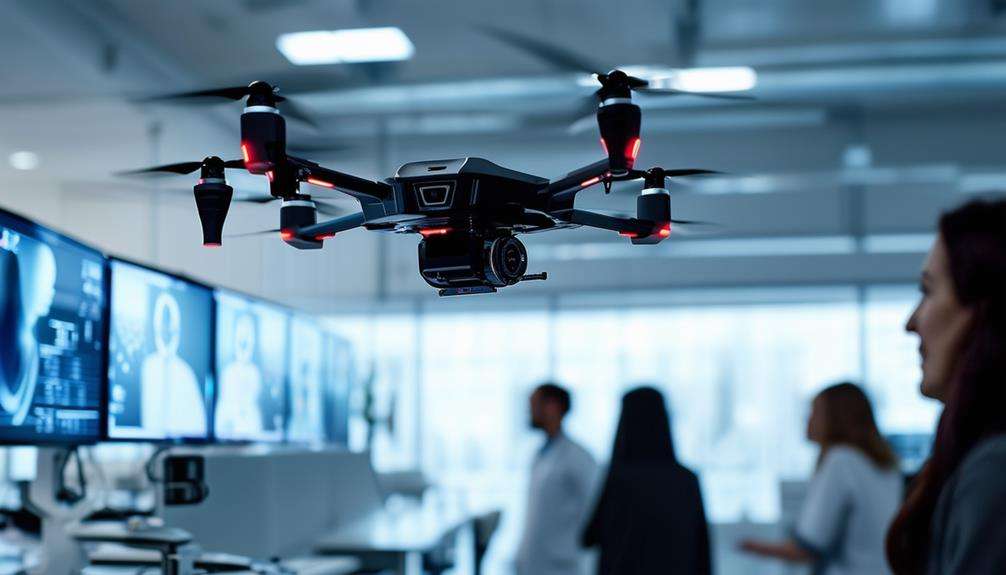Are Drone Jammers Legal?

Drone jammers are generally illegal for individual use across many countries. In the U.S., operating or selling them without federal authorization leads to hefty fines and legal consequences due to the Communications Act of 1934. Other regions like the European Union and Canada also enforce strict laws, with usage restricted to government entities. These rules protect critical communication systems and airspace safety. Unauthorized jamming can disrupt essential services, posing severe risks. While legal nuances vary globally, compliance ensures public safety and avoids severe penalties. There's much more to explore about the ethics and future of drone jamming technology.
Key Takeaways
- Drone jammers are illegal for public use in the United States under the Communications Act of 1934.
- Only federal agencies in the United States are authorized to operate drone jammers.
- The European Union prohibits drone jammers under Directive 1999/5/EC for telecommunications equipment.
- Canada restricts drone jammer use to federal law enforcement under the Radiocommunication Act.
- Australia requires a PMTS C telecommunications license for legal operation of drone jammers.
Understanding Drone Jammers
Dive into the world of drone jammers, devices designed to break the communication link between drones and their operators. Drone jamming technology primarily disrupts radio signals on frequencies like 2.4 GHz or 5.8 GHz, which are commonly used by drones. By doing so, these radio signal jammers effectively cause drones to either land or return to their home location. However, the use of this technology is a complex issue, particularly when it comes to who actually has the legal authority to use them. In the United States, only federal agencies are permitted to operate drone jammers under strict FCC regulations. These rules explicitly prohibit individuals or local law enforcement from manufacturing, selling, or using these devices. This is similar to how Texas State Drone Laws enforce compliance with specific regulations for drone operations. The legal framework is based on the Communications Act of 1934, and unauthorized use can result in hefty fines and even criminal charges. Safety concerns also arise with drone jammers, as they may inadvertently interfere with critical systems like aviation and healthcare, posing additional risks. Therefore, understanding the legal restrictions and potential implications of using drone jammers is essential to avoid significant legal and safety issues. Always stay informed about evolving regulations surrounding their use.
Global Legality Overview
The complexity of drone jammers' legality underscores the importance of understanding international regulations. Across the globe, laws vary significantly, affecting how you can use or even own these devices. In many countries, it's illegal to sell or use drone jammers, with strict penalties in place.
Here's a snapshot of global regulations:
| Country | Regulation Overview |
|---|---|
| United States | Illegal to sell or use under the Communications Act of 1934; fines up to $112,000. |
| European Union | Prohibited under Directive 1999/5/EC, affecting all telecommunications equipment. |
| Canada | Use restricted under the Radiocommunication Act, except for federal government law enforcement. |
| Australia | Unauthorized use is illegal; only individuals with a PMTS C telecommunications license can use jammers. |
| United Kingdom | Legal to own, but illegal to use outside specific contexts like prisons. |
In Canada, the federal government strictly controls drone jammers, with exceptions only for law enforcement. Meanwhile, in Australia, a PMTS C telecommunications license is required, making unauthorized use illegal. The European Union takes a stringent approach under Directive 1999/5/EC, reinforcing that you're not allowed to use jammers. Understanding these nuances is crucial if you're considering the use of drone jammers internationally.
U.S. Laws and Regulations

In the United States, the operation, sale, and use of drone jammers are deemed illegal under the Communications Act of 1934. This act explicitly prohibits any interference with radio communications, a category into which drone jammers directly fall. The Federal Communications Commission (FCC) is tasked with enforcing these strict regulations, and they allow the use of jamming devices only for federal agencies and authorized government entities. The regulations around drone jammers align with the robust safety protocols needed for safe integration of drones into national airspace, as unauthorized jammers could disrupt these systems. If you're thinking about using a drone jammer, it's crucial to know that unauthorized use can lead to severe penalties. These penalties might include hefty fines and even criminal charges, primarily because drone jammers have the potential to disrupt critical communication systems. There's also the risk of causing drone crashes or interfering with essential operations, which adds a layer of legal liability for civilian users. The only exceptions to these rules are specific law enforcement and military applications, which require appropriate authorization. Without this, using drone jammers in the U.S. can lead to significant legal trouble, so it's best to steer clear unless you have official clearance.
Regional Legal Variations
Understanding the regional legal variations concerning drone jammers is crucial if you're navigating international laws. In the United States, drone jammers are strictly off-limits for private individuals. Only federal security agencies can use them, and even then, they're bound by stringent regulations. Jumping across the pond to the United Kingdom, you'll find that owning a drone jammer isn't prohibited, but using one is illegal for most. Exceptions exist for specific security agencies, like prisons, which have been allowed to utilize them since 2012.
In Australia, the situation changes again. While owning a drone jammer might be possible, using one without a PMTS C telecommunications license is against the law. Meanwhile, in Canada, the Radiocommunication Act clearly prohibits jammer use, reserving exceptions for federal law enforcement agencies under particular circumstances.
India provides another unique case where drone jammers are legal, but only for security agencies that hold the necessary permits. Their use is confined to authorized personnel, ensuring control and compliance with national security standards. These legal variations highlight the importance of understanding local laws before considering the purchase or use of drone jammers anywhere in the world.
Enforcement and Penalties

When dealing with drone jammers, it's essential to grasp the enforcement measures and penalties that come with unauthorized use. Different countries have stringent regulations to control the use of jamming devices, primarily to protect federal security and ensure public safety. In the United States, unauthorized operation or sale of these devices can result in hefty fines up to $112,000 under the Communications Act of 1934. This federal enforcement aims to deter individuals and organizations from interfering with communication systems.
In Italy, the penalties are even more severe, with individuals facing imprisonment for up to eight years if found in possession or using jammers. Australia mandates that operating a jammer without a PMTS C telecommunications license is illegal, leading to significant enforcement and penalties. Similarly, Malaysia imposes strict fines up to RM500,000 or potential imprisonment for illegal jammer use, emphasizing the seriousness of these violations.
Canada's enforcement focuses on non-compliant individuals and organizations, as unauthorized jammer use violates the Radiocommunication Act. These diverse penalties highlight the global commitment to controlling jamming devices, ensuring they don't compromise federal security or disrupt essential services. Understanding these regulations is crucial if you're considering drone jammers for any reason.
Ethical and Safety Concerns
Drone jammers often raise serious ethical and safety concerns. When you use them, you risk disrupting legitimate drone operations, which can jeopardize public safety and the critical work of emergency services. Imagine a drone delivering medical supplies or capturing important footage during a crisis, only to be suddenly disabled by unauthorized jamming. The consequences could be dire, especially in crowded airspaces like airports, where interference with aircraft communications poses significant risks.
Moreover, unauthorized jamming can lead to unintended collateral damage. A drone forced to crash might cause injury or property damage to unsuspecting bystanders. It's not just about the immediate physical risks; there's also the potential for misuse. Individuals might deploy jammers to evade detection or sabotage lawful activities, raising serious alarms over privacy rights and civil liberties.
The technology itself lacks precision, further complicating its use. Jammers might inadvertently affect multiple devices within their range, creating unintended safety hazards. This lack of control only amplifies the ethical concerns surrounding their deployment. When you consider these factors, it's clear that using drone jammers is fraught with challenges that can't be ignored, especially when public safety and ethical responsibilities are on the line.
Future of Drone Jamming Technology

Picture a future where drone jamming technology becomes as precise as a surgeon's scalpel, targeting specific drone frequencies while leaving other communications untouched. This vision isn't far-fetched. As drone technology advances, so does the need for sophisticated anti-drone technologies. The focus is shifting toward selective jamming devices that pinpoint unauthorized drones without disrupting other radio frequencies. Imagine a world where drone jammers can neutralize rogue drones effectively, ensuring safety and minimizing collateral damage.
Ongoing research aims to tackle challenges like precise targeting and efficient resource allocation. Innovations are paving the way for radio frequency jammers that can distinguish between different signals, allowing for more controlled and lawful use. This precision is crucial in national security contexts, where recent breaches highlight the importance of integrating drone jammers into defense strategies.
As these technologies evolve, the establishment of federal guidelines becomes increasingly important. Clear regulations will ensure that the use of drone jammers aligns with legal standards and safety requirements. By setting these parameters, you can ensure that anti-drone technologies are used responsibly and effectively, securing airspace without compromising other essential communications. The future of drone jamming technology is both promising and necessary.




